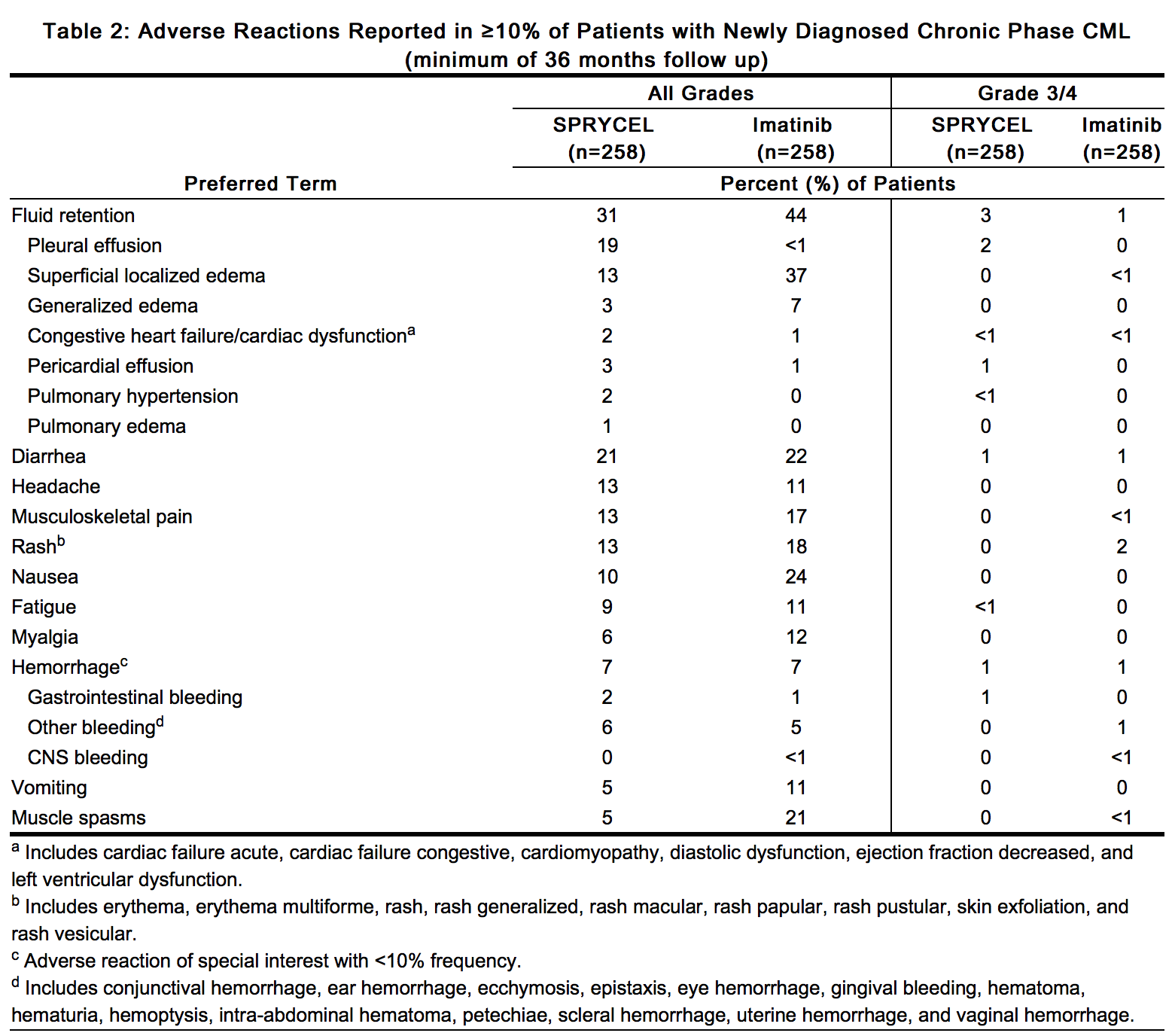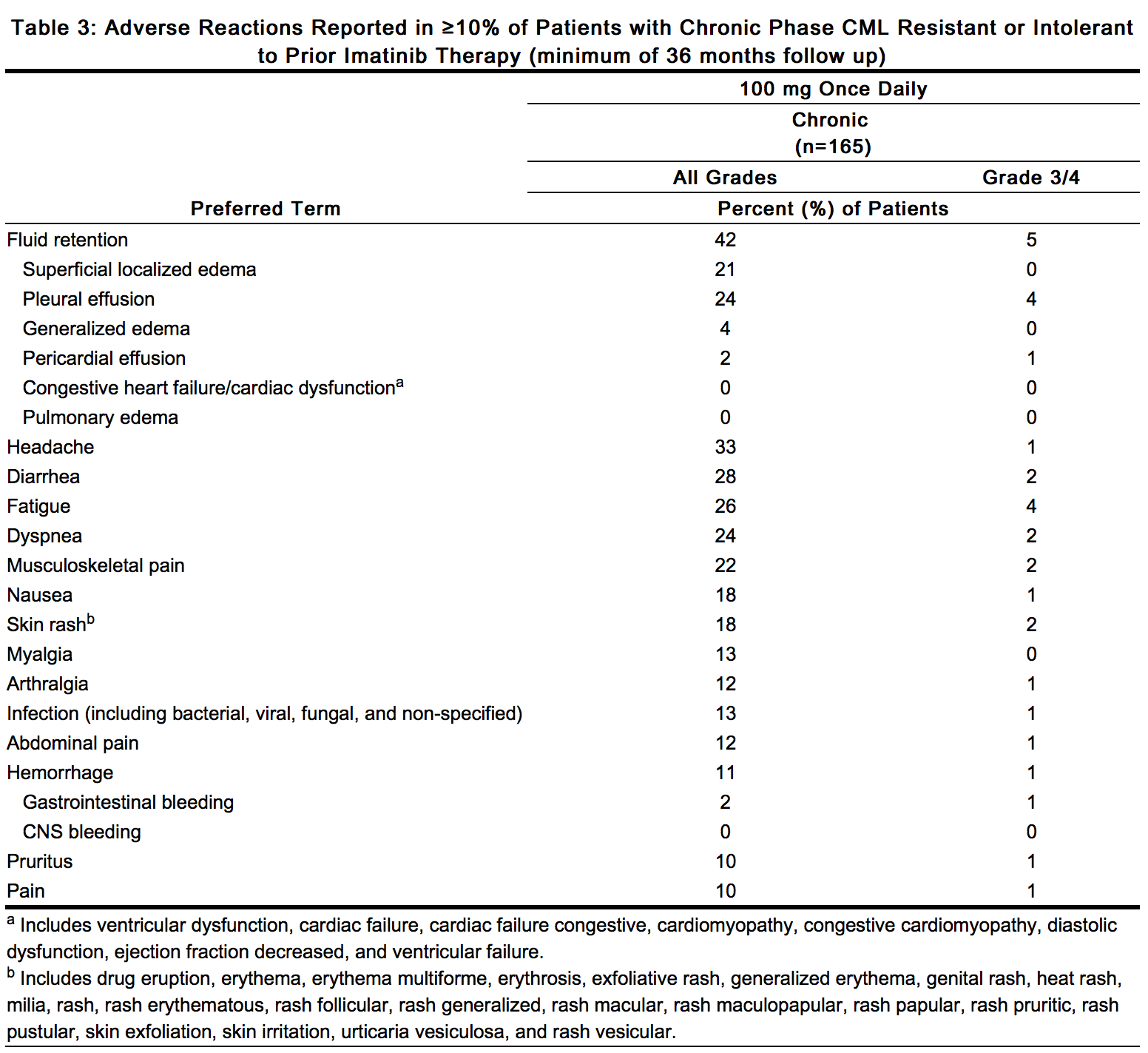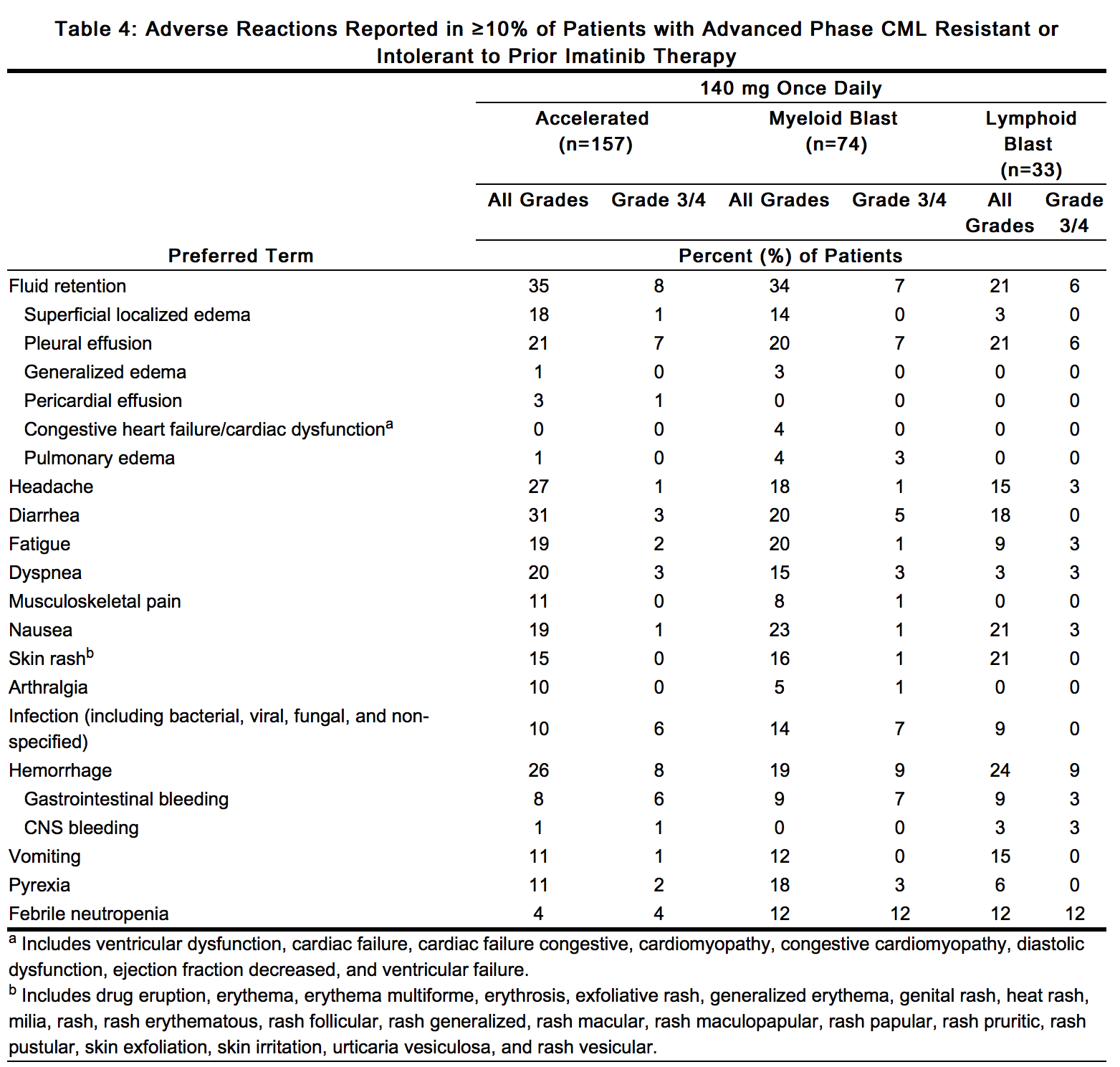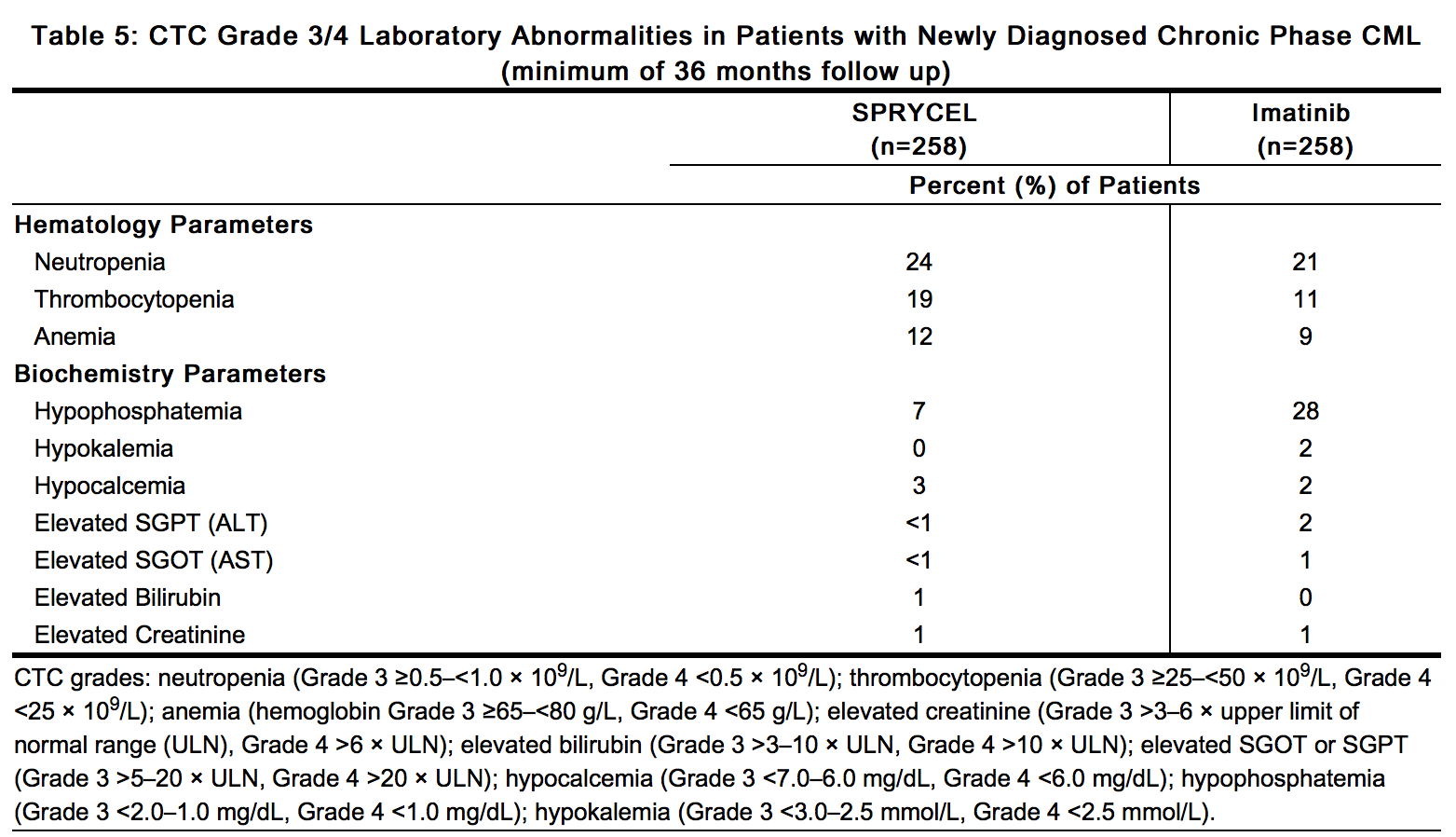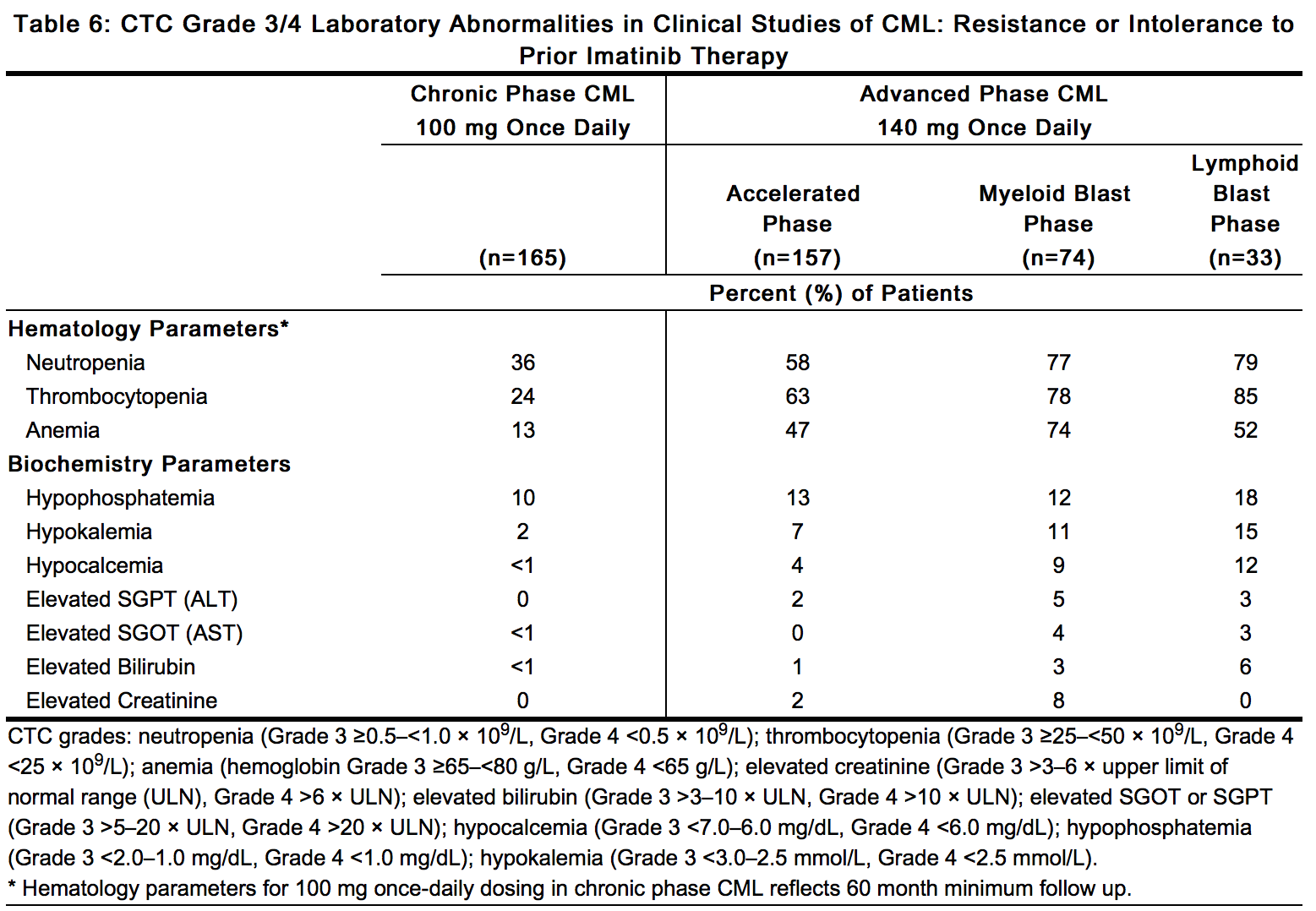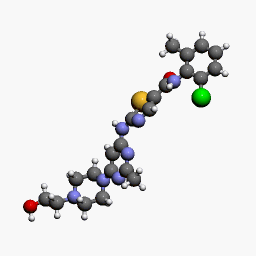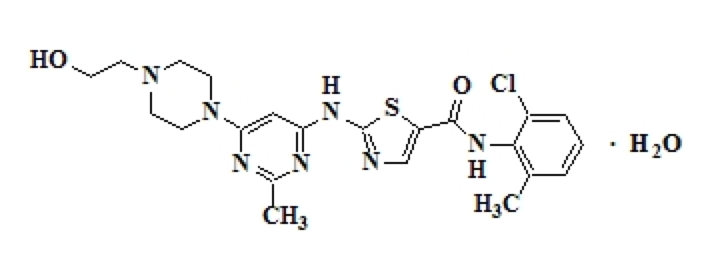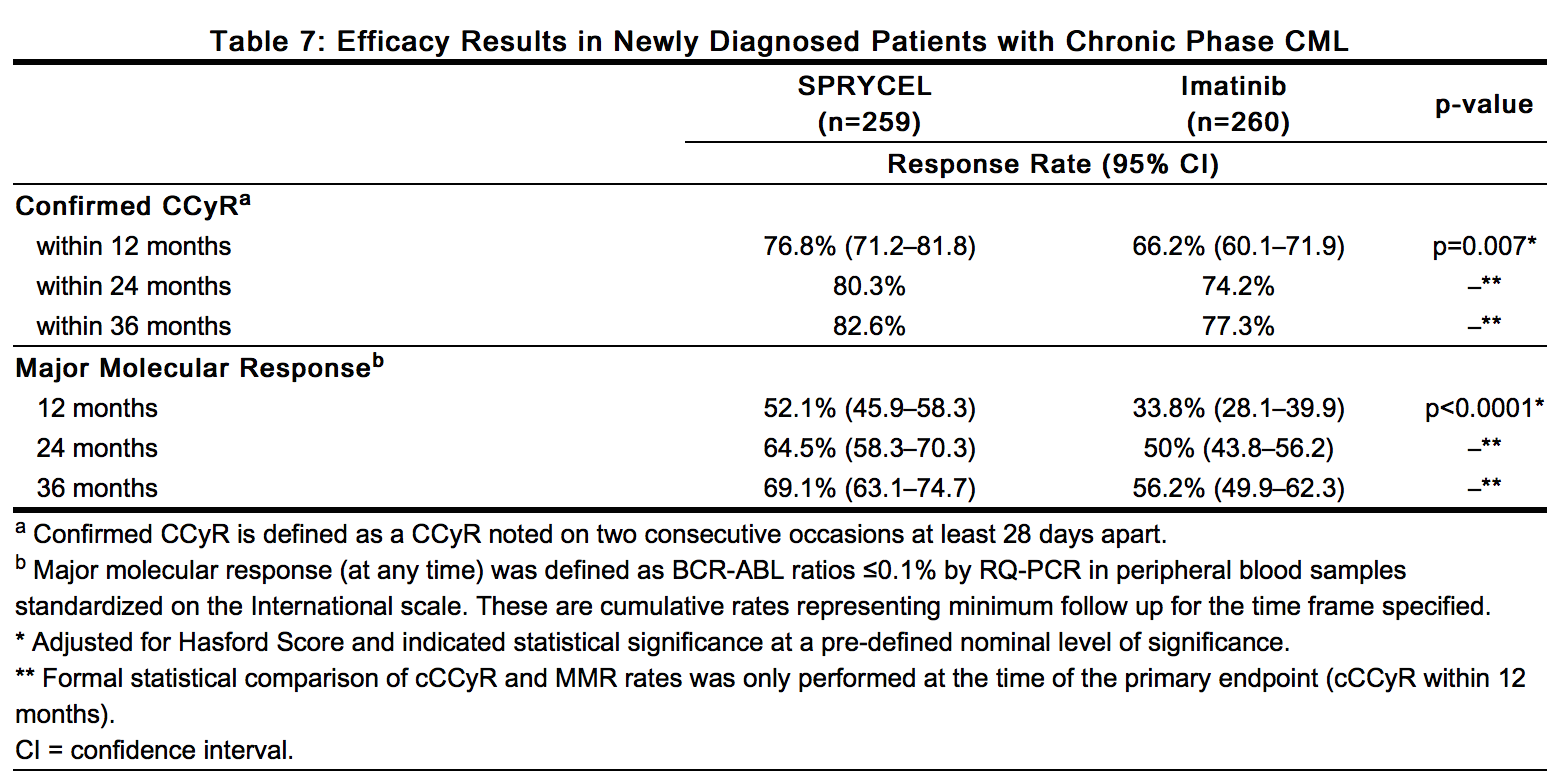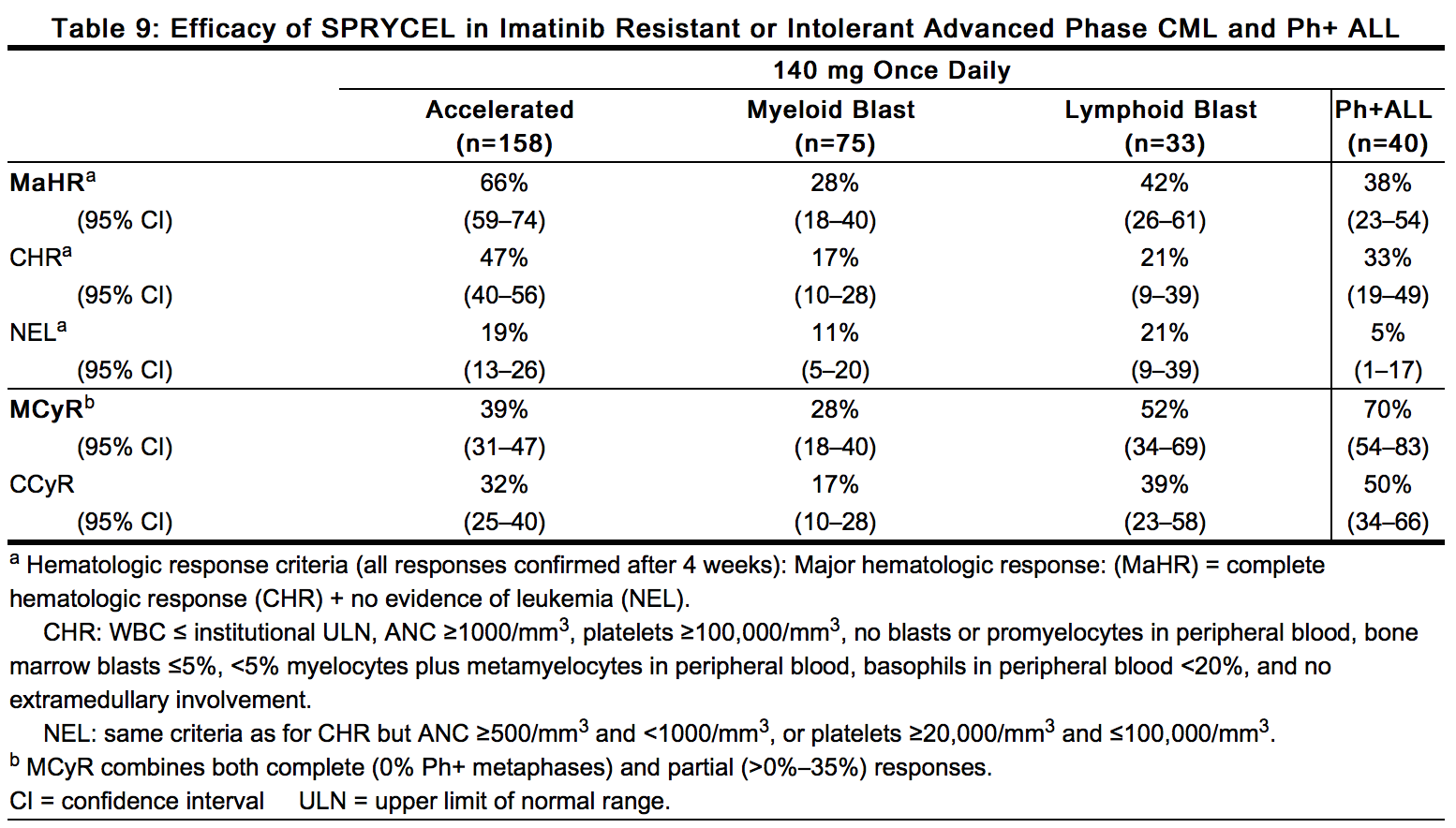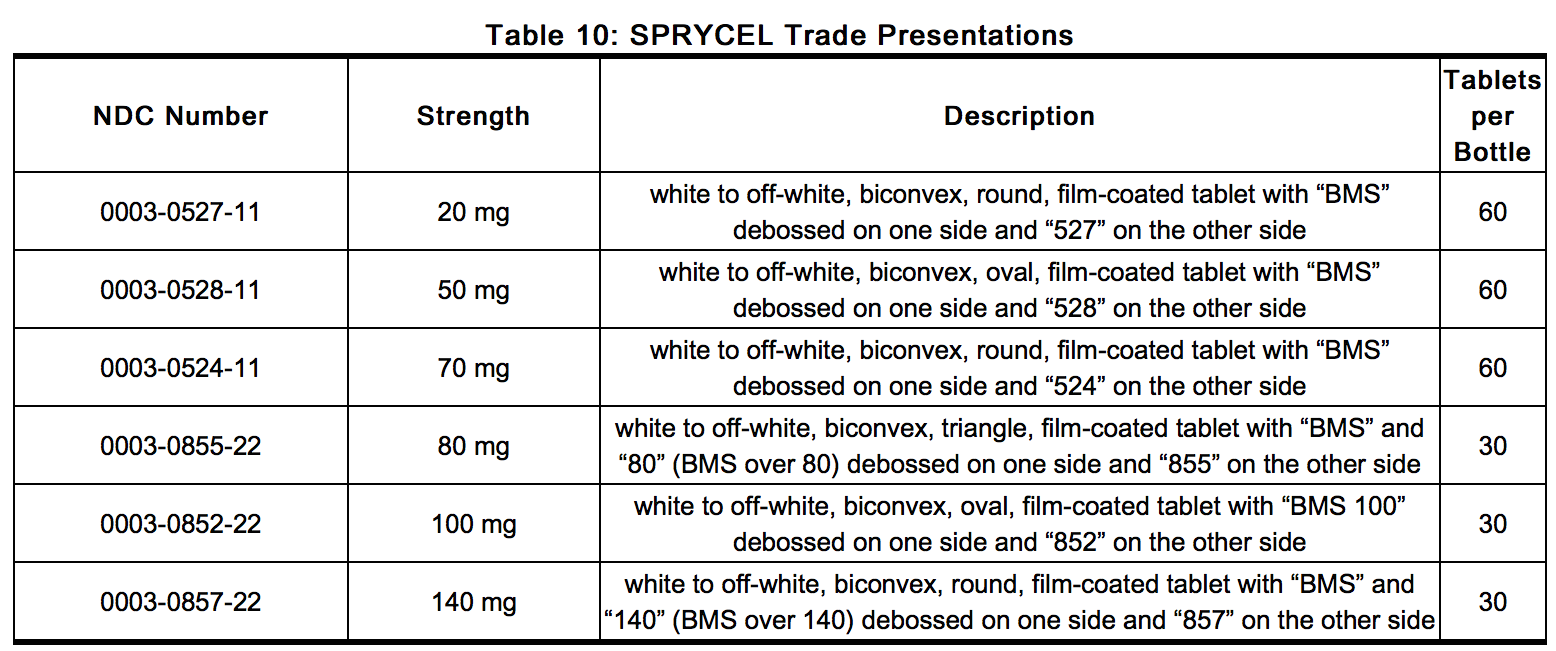Dasatinib
Editor-In-Chief: C. Michael Gibson, M.S., M.D. [1]; Associate Editor(s)-in-Chief: Kiran Singh, M.D. [2]
Disclaimer
WikiDoc MAKES NO GUARANTEE OF VALIDITY. WikiDoc is not a professional health care provider, nor is it a suitable replacement for a licensed healthcare provider. WikiDoc is intended to be an educational tool, not a tool for any form of healthcare delivery. The educational content on WikiDoc drug pages is based upon the FDA package insert, National Library of Medicine content and practice guidelines / consensus statements. WikiDoc does not promote the administration of any medication or device that is not consistent with its labeling. Please read our full disclaimer here.
Overview
Dasatinib is a tyrosine kinase inhibitor that is FDA approved for the treatment of Philadelphia chromosome-positive chronic myeloid leukemia or acute lymphoblastic leukemia. Common adverse reactions include myelosuppression, fluid retention, diarrhea, headache, dyspnea, rash, fatigue, nausea, and hemorrhage.
Adult Indications and Dosage
FDA-Labeled Indications and Dosage (Adult)
Chronic Myeloid Leukemia or Acute Lymphoblastic Leukemia
- Dosing Information
- The recommended starting dosage of Sprycel for chronic phase CML is 100 mg administered orally once daily. The recommended starting dosage of Sprycel for accelerated phase CML, myeloid or lymphoid blast phase CML, or Ph+ ALL is 140 mg administered orally once daily. Tablets should not be crushed or cut; they should be swallowed whole. Sprycel can be taken with or without a meal, either in the morning or in the evening.
- In clinical studies, treatment with Sprycel was continued until disease progression or until no longer tolerated by the patient. The effect of stopping treatment after the achievement of a complete cytogenetic response (CCyR) has not been investigated.
Off-Label Use and Dosage (Adult)
Guideline-Supported Use
There is limited information regarding Off-Label Guideline-Supported Use of Dasatinib in adult patients.
Non–Guideline-Supported Use
There is limited information regarding Off-Label Non–Guideline-Supported Use of Dasatinib in adult patients.
Pediatric Indications and Dosage
FDA-Labeled Indications and Dosage (Pediatric)
- The safety and efficacy of Sprycel in patients less than 18 years of age have not been established.
Off-Label Use and Dosage (Pediatric)
Guideline-Supported Use
There is limited information regarding Off-Label Guideline-Supported Use of Dasatinib in pediatric patients.
Non–Guideline-Supported Use
There is limited information regarding Off-Label Non–Guideline-Supported Use of Dasatinib in pediatric patients.
Contraindications
- None
Warnings
Myelosuppression
- Treatment with Sprycel is associated with severe (NCI CTC Grade 3 or 4) thrombocytopenia, neutropenia, and anemia. Their occurrence is more frequent in patients with advanced phase CML or Ph+ ALL than in chronic phase CML. In a dose-optimization trial in patients with resistance or intolerance to prior imatinib therapy and chronic phase CML, Grade 3 or 4 myelosuppression was reported less frequently in patients treated with 100 mg once daily than in patients treated with other dosing regimens.
- Perform complete blood counts weekly for the first 2 months and then monthly thereafter, or as clinically indicated. Myelosuppression was generally reversible and usually managed by withholding Sprycel temporarily or dose reduction.
Bleeding Related Events
- In addition to causing thrombocytopenia in human subjects, dasatinib caused platelet dysfunction in vitro. In all clinical studies, severe central nervous system (CNS) hemorrhages, including fatalities, occurred in 1% of patients receiving Sprycel. Severe gastrointestinal hemorrhage, including fatalities, occurred in 4% of patients and generally required treatment interruptions and transfusions. Other cases of severe hemorrhage occurred in 2% of patients. Most bleeding events were associated with severe thrombocytopenia.
- Patients were excluded from participation in initial Sprycel clinical studies if they took medications that inhibit platelet function or anticoagulants. In subsequent trials, the use of anticoagulants, aspirin, and non-steroidal anti-inflammatory drugs (NSAIDs) was allowed concurrently with Sprycel if the platelet count was >50,000–75,000 per microliter. Exercise caution if patients are required to take medications that inhibit platelet function or anticoagulants.
Fluid Retention
- Sprycel is associated with fluid retention. In clinical trials, severe fluid retention was reported in up to 10% of patients. Severe ascites, pulmonary edema, and generalized edema were each reported in ≤1% of patients. Patients who develop symptoms suggestive of pleural effusion, such as dyspnea or dry cough, should be evaluated by chest x-ray. Severe pleural effusion may require thoracentesis and oxygen therapy. Fluid retention events were typically managed by supportive care measures that include diuretics or short courses of steroids. In dose-optimization studies, fluid retention events were reported less frequently with once daily dosing than with other dosing regimens.
QT Prolongation
- In vitro data suggest that dasatinib has the potential to prolong cardiac ventricular repolarization (QT interval). Of the 2440 patients treated with Sprycel in clinical studies, 16 patients (1%) had QTc prolongation reported as an adverse reaction. Twenty-two patients (1%) experienced a QTcF >500 ms. In 865 patients with leukemia treated with Sprycel in five Phase 2 single-arm studies, the maximum mean changes in QTcF (90% upper bound CI) from baseline ranged from 7.0 ms to 13.4 ms.
- Administer Sprycel with caution to patients who have or may develop prolongation of QTc. These include patients with hypokalemia or hypomagnesemia, patients with congenital long QT syndrome, patients taking anti-arrhythmic medicines or other medicinal products that lead to QT prolongation, and cumulative high-dose anthracycline therapy. Correct hypokalemia or hypomagnesemia prior to Sprycel administration.
Congestive Heart Failure, Left Ventricular Dysfunction, and Myocardial Infarction
- Cardiac adverse reactions were reported in 7% of 258 patients taking Sprycel, including, 1.6% of patients with cardiomyopathy, congestive heart failure, diastolic dysfunction, fatal myocardial infarction, and left ventricular dysfunction. Monitor patients for signs or symptoms consistent with cardiac dysfunction and treat appropriately.
Pulmonary Arterial Hypertension
- Sprycel may increase the risk of developing pulmonary arterial hypertension (PAH) which may occur any time after initiation, including after more than one year of treatment. Manifestations include dyspnea, fatigue, hypoxia, and fluid retention. PAH may be reversible on discontinuation of Sprycel. Evaluate patients for signs and symptoms of underlying cardiopulmonary disease prior to initiating Sprycel and during treatment. If PAH is confirmed, Sprycel should be permanently discontinued.
Embryo-fetal Toxicity
- Sprycel can cause fetal harm when administered to a pregnant woman. Adverse fetal and infant outcomes have been reported from women who have taken Sprycel during pregnancy. In animal reproduction studies, embryo-fetal toxicities, including skeletal malformations, were observed in rats and rabbits at plasma concentrations below those in humans receiving therapeutic doses of dasatinib. If Sprycel is used during pregnancy, or if the patient becomes pregnant while taking Sprycel, the patient should be apprised of the potential hazard to the fetus.
- Advise females of reproductive potential to avoid pregnancy, which may include the use of contraception, during treatment with Sprycel.
Adverse Reactions
Clinical Trials Experience
- Because clinical trials are conducted under widely varying conditions, adverse reaction rates observed in the clinical trials of a drug cannot be directly compared to rates in the clinical trials of another drug and may not reflect the rates observed in practice.
- The data described below reflect exposure to Sprycel in clinical studies including 258 patients with newly diagnosed chronic phase CML and in 2182 patients with imatinib resistant or intolerant CML or Ph+ ALL.
- In the newly diagnosed chronic phase CML trial with a minimum of 36 months follow up and median duration of therapy of 37 months, the median average daily dose was 99 mg.
- In the imatinib resistant or intolerant CML or Ph+ ALL clinical trials, 1520 patients had a minimum of 2 years follow up and 662 patients with chronic phase CML had a minimum of 60 months follow up (starting dosage 100 mg once daily, 140 mg once daily, 50 mg twice daily, or 70 mg twice daily). Among patients with chronic phase CML and resistance or intolerance to prior imatinib therapy, the median duration of treatment with Sprycel 100 mg once daily was 37 months (range 1–65 months). The median duration of treatment with Sprycel 140 mg once daily was 15 months (range 0.03–36 months) for accelerated phase CML, 3 months (range 0.03–29 months) for myeloid blast phase CML, and 3 months (range 0.1–10 months) for lymphoid blast CML.
- The majority of Sprycel-treated patients experienced adverse reactions at some time. In the newly diagnosed chronic phase CML trial, drug was discontinued for adverse reactions in 6% of Sprycel-treated patients with a minimum of 12 months follow up. After a minimum of 36 months follow up, the cumulative discontinuation rate was 9%. Among patients with resistance or intolerance to prior imatinib therapy, the rates of discontinuation for adverse reactions at 2 years were 15% in chronic phase CML for all dosages, 16% in accelerated phase CML, 15% in myeloid blast phase CML, 8% in lymphoid blast phase CML, and 8% in Ph+ ALL. In a dose-optimization trial in patients with resistance or intolerance to prior imatinib therapy and chronic phase CML with a minimum of 60 months follow up, the rate of discontinuation for adverse reactions was 18% in patients treated with 100 mg once daily.
- The most frequently reported adverse reactions reported in ≥10% of patients in newly diagnosed chronic phase CML included myelosuppression, fluid retention events (pleural effusion, superficial localized edema, generalized edema), diarrhea, headache, musculoskeletal pain, rash, and nausea. Pleural effusions were reported in 50 patients (see Table 2).
- The most frequently reported adverse reactions reported in ≥20% of patients with resistance or intolerance to prior imatinib therapy included myelosuppression, fluid retention events, diarrhea, headache, dyspnea, skin rash, fatigue, nausea, and hemorrhage.
- The most frequently reported serious adverse reactions in patients with newly diagnosed chronic phase CML included pleural effusion (4%), hemorrhage (2%), congestive heart failure (1%), pulmonary hypertension (1%), and pyrexia (1%). The most frequently reported serious adverse reactions in patients with resistance or intolerance to prior imatinib therapy included pleural effusion (11%), gastrointestinal bleeding (4%), febrile neutropenia (4%), dyspnea (3%), pneumonia (3%), pyrexia (3%), diarrhea (3%), infection (2%), congestive heart failure/cardiac dysfunction (2%), pericardial effusion (1%), and CNS hemorrhage (1%).
Chronic Myeloid Leukemia (CML)
- Adverse reactions (excluding laboratory abnormalities) that were reported in at least 10% of patients are shown in Table 2 for newly diagnosed patients with chronic phase CML and Tables 3 and 4 for CML patients with resistance or intolerance to prior imatinib therapy.
- The cumulative rates of the majority of adverse reactions (all grades) in newly diagnosed patients with chronic phase CML were similar after 12 and 36 months minimum follow up including congestive heart failure/cardiac dysfunction (2% vs 2%), pericardial effusion (2% vs 3%), pulmonary edema (<1% vs 1%), gastrointestinal bleeding (2% vs 2%), diarrhea (18% vs 21%), and generalized edema (3% vs 3%). Cumulative adverse reaction rates (all grades) that increased between 12 months and 36 months minimum follow up included overall fluid retention (23% vs 31%), pleural effusion (12% vs 19%), and superficial edema (10% vs 13%). A total of 9 patients (3.5%) discontinued due to pleural effusion in the trial.
- At 36 months, there were 17 deaths in the dasatinib-treated patients (6.6%) and 20 deaths in the imatinib-treated patients (7.7%); 1 in each group was judged by the investigator as related to study therapy.
- With a minimum follow up of 60 months (see Table 3), the cumulative rates of the majority of adverse reactions (all grades) in patients with chronic phase CML treated with a starting dose of 100 mg once daily were identical with a minimum follow up of 24 and 60 months including congestive heart failure/cardiac dysfunction, pericardial effusion, pulmonary edema, and gastrointestinal bleeding or similar for diarrhea (27% vs 28%), and generalized edema (3% vs 4%). Cumulative adverse reaction rates (all grades) that increased between 24 months and 60 months minimum follow up included: overall fluid retention (34% vs 42%), pleural effusion (18% vs 24%), and superficial edema (18% vs 21%). The cumulative rate of Grade 3 or 4 pleural effusion was 2% versus 4%, respectively.
Laboratory Abnormalities
- Myelosuppression was commonly reported in all patient populations. The frequency of Grade 3 or 4 neutropenia, thrombocytopenia, and anemia was higher in patients with advanced phase CML than in chronic phase CML (Tables 5 and 6). Myelosuppression was reported in patients with normal baseline laboratory values as well as in patients with pre-existing laboratory abnormalities.
- In patients who experienced severe myelosuppression, recovery generally occurred following dose interruption or reduction; permanent discontinuation of treatment occurred in 2% of patients with newly diagnosed chronic phase CML and 5% of patients with resistance or intolerance to prior imatinib therapy.
- Grade 3 or 4 elevations of transaminase or bilirubin and Grade 3 or 4 hypocalcemia, hypokalemia, and hypophosphatemia were reported in patients with all phases of CML but were reported with an increased frequency in patients with myeloid or lymphoid blast phase CML. Elevations in transaminase or bilirubin were usually managed with dose reduction or interruption. Patients developing Grade 3 or 4 hypocalcemia during the course of Sprycel therapy often had recovery with oral calcium supplementation.
- Laboratory abnormalities reported in patients with newly diagnosed chronic phase CML are shown in Table 5. There were no discontinuations of Sprycel therapy in this patient population due to biochemical laboratory parameters.
- Laboratory abnormalities reported in patients with CML resistant or intolerant to imatinib who received the recommended starting doses of Sprycel are shown by disease phase in Table 6.
- Among chronic phase CML patients with resistance or intolerance to prior imatinib therapy, cumulative Grade 3 or 4 cytopenias were similar at 2 and 5 years including: neutropenia (36% vs 36%), thrombocytopenia (23% vs 24%) and anemia (13% vs 13%).
Philadelphia Chromosome-Positive Acute Lymphoblastic Leukemia (Ph+ ALL)
- A total of 135 patients with Ph+ ALL were treated with Sprycel in clinical studies. The median duration of treatment was 3 months (range 0.03–31 months). The safety profile of patients with Ph+ ALL was similar to those with lymphoid blast phase CML. The most frequently reported adverse reactions included fluid retention events, such as pleural effusion (24%) and superficial edema (19%), and gastrointestinal disorders, such as diarrhea (31%), nausea (24%), and vomiting (16%). Hemorrhage (19%), pyrexia (17%), rash (16%), and dyspnea (16%) were also frequently reported. The most frequently reported serious adverse reactions included pleural effusion (11%), gastrointestinal bleeding (7%), febrile neutropenia (6%), infection (5%), pyrexia (4%), pneumonia (3%), diarrhea (3%), nausea (2%), vomiting (2%), and colitis (2%).
Additional Data From Clinical Trials
- The following adverse reactions were reported in patients in the Sprycel clinical studies at a frequency of ≥10%, 1%–<10%, 0.1%–<1%, or <0.1%. These events are included on the basis of clinical relevance.
Body as a Whole
- 1%–<10% – asthenia, pain, chest pain, chills
- 0.1%–<1% – malaise, temperature intolerance.
Cardiovascular
- 1%–<10% – arrhythmia (including tachycardia), palpitations, flushing, hypertension
- 0.1%–<1% – angina pectoris, cardiomegaly, pericarditis, ventricular arrhythmia (including ventricular tachycardia), hypotension, thrombophlebitis
Digestive
- 1%–<10% – mucosal inflammation (including mucositis/stomatitis), dyspepsia, abdominal distension, constipation, gastritis, colitis (including neutropenic colitis), oral soft tissue disorder
- 0.1%–<1% – ascites, dysphagia, anal fissure, upper gastrointestinal ulcer, esophagitis, pancreatitis
- <0.1% – protein losing gastroenteropathy, ileus
Hematologic and Lymphatic
- 1%–<10% – pancytopenia
- <0.1% – pure red cell aplasia
Metabolic and Nutritional
- 1%–<10% – anorexia, appetite disturbances, hyperuricemia
- 0.1%–<1% – hypoalbuminemia
Musculoskeletal
- 1%–<10% – muscular weakness, musculoskeletal stiffness, muscle spasm
- 0.1%–<1% – rhabdomyolysis, tendonitis, muscle inflammation
Neurologic
- 1%–<10% – neuropathy (including peripheral neuropathy), dizziness, dysgeusia, somnolence
- 0.1%–<1% – amnesia, tremor, syncope
- <0.1% – convulsion, cerebrovascular accident, transient ischemic attack, optic neuritis, CN VII paralysis
Respiratory
- ≥10% ‒ cough
- 1%–<10% – lung infiltration, pneumonitis, pulmonary hypertension
- 0.1%–<1% – asthma, bronchospasm
- <0.1% – acute respiratory distress syndrome
Skin and Hypersensitivy Reactions
- 1%–<10% – pruritus, alopecia, acne, dry skin, hyperhidrosis, urticaria, dermatitis (including eczema)
- 0.1%–<1% – pigmentation disorder, skin ulcer, bullous conditions, photosensitivity, nail disorder, acute febrile neutrophilic dermatosis, panniculitis, palmar-plantar erythrodysesthesia syndrome
Infections
- 1%–<10% – pneumonia (including bacterial, viral, and fungal), upper respiratory tract infection/inflammation, herpes virus infection, enterocolitis infection, sepsis (including fatal outcomes)
Laboratory
- 1%–<10% – weight increased, weight decreased
- 0.1%–<1% – blood creatine phosphokinase increased
Psychiatric
- 1%–<10% – insomnia, depression
- 0.1%–<1% – anxiety, affect lability, confusional state, libido decreased
Reproductive System and Breast Disorders
- 0.1%–<1% – gynecomastia, irregular menstruation
Injury, Poisoning, and Procedural Complications
- 1%–<10% – contusion
Ear and Labyrinth Disorders
Hepatobiliary Disorders
- 0.1%–<1% – cholestasis, cholecystitis, hepatitis
Renal and Urinary Disorders
- 0.1%–<1% – urinary frequency, renal failure, proteinuria
Neoplasms Benign, Malignant, and Unspecified
- 0.1%–<1% – tumor lysis syndrome
Immune System Disorders
- 0.1%–<1% – hypersensitivity (including erythema nodosum)
Miscellaneous
- 1%–<10% – visual disorder (including visual disturbance, vision blurred, and visual acuity reduced), dry eye
- 0.1% –<1% – conjunctivitis
- <0.1% – visual impairment
Postmarketing Experience
- The following additional adverse reactions have been identified during post approval use of Sprycel. Because these reactions are reported voluntarily from a population of uncertain size, it is not always possible to reliably estimate their frequency or establish a causal relationship to drug exposure.
Cardiovascular
- Atrial fibrillation/atrial flutter, thrombosis/embolism (including pulmonary embolism, deep vein thrombosis)
Respiratory
Drug Interactions
Drugs That May Increase Dasatinib Plasma Concentrations
- CYP3A4 Inhibitors: Dasatinib is a CYP3A4 substrate. In a trial of 18 patients with solid tumors, 20-mg Sprycel once daily coadministered with 200 mg of ketoconazole twice daily increased the dasatinib Cmax and AUC by four- and five-fold, respectively. Concomitant use of Sprycel and drugs that inhibit CYP3A4 may increase exposure to dasatinib and should be avoided. In patients receiving treatment with Sprycel, close monitoring for toxicity and a Sprycel dose reduction should be considered if systemic administration of a potent CYP3A4 inhibitor cannot be avoided.
Drugs That May Decrease Dasatinib Plasma Concentrations
- CYP3A4 Inducers: When a single morning dose of Sprycel was administered following 8 days of continuous evening administration of 600 mg of rifampin, a potent CYP3A4 inducer, the mean Cmax and AUC of dasatinib were decreased by 81% and 82%, respectively. Alternative agents with less enzyme induction potential should be considered. If Sprycel must be administered with a CYP3A4 inducer, a dose increase in Sprycel should be considered.
- Antacids: Nonclinical data demonstrate that the solubility of dasatinib is pH dependent. In a trial of 24 healthy subjects, administration of 30 mL of aluminum hydroxide/magnesium hydroxide 2 hours prior to a single 50-mg dose of Sprycel was associated with no relevant change in dasatinib AUC; however, the dasatinib Cmax increased 26%. When 30 mL of aluminum hydroxide/magnesium hydroxide was administered to the same subjects concomitantly with a 50-mg dose of Sprycel, a 55% reduction in dasatinib AUC and a 58% reduction in Cmax were observed. Simultaneous administration of Sprycel with antacids should be avoided. If antacid therapy is needed, the antacid dose should be administered at least 2 hours prior to or 2 hours after the dose of Sprycel.
- H2 Antagonists/Proton Pump Inhibitors: Long-term suppression of gastric acid secretion by H2 antagonists or proton pump inhibitors (eg, famotidine and omeprazole) is likely to reduce dasatinib exposure. In a trial of 24 healthy subjects, administration of a single 50-mg dose of Sprycel 10 hours following famotidine reduced the AUC and Cmax of dasatinib by 61% and 63%, respectively. In a trial of 14 healthy subjects, administration of a single 100-mg dose of Sprycel 22 hours following a 40-mg omeprazole dose at steady state reduced the AUC and Cmax of dasatinib by 43% and 42%, respectively. The concomitant use of H2 antagonists or proton pump inhibitors with Sprycel is not recommended. The use of antacids (at least 2 hours prior to or 2 hours after the dose of Sprycel) should be considered in place of H2 antagonists or proton pump inhibitors in patients receiving Sprycel therapy.
Drugs That May Have Their Plasma Concentration Altered By Dasatinib
- CYP3A4 Substrates: Single-dose data from a trial of 54 healthy subjects indicate that the mean Cmax and AUC of simvastatin, a CYP3A4 substrate, were increased by 37% and 20%, respectively, when simvastatin was administered in combination with a single 100-mg dose of Sprycel. Therefore, CYP3A4 substrates known to have a narrow therapeutic index such as alfentanil, astemizole, terfenadine, cisapride, cyclosporine, fentanyl, pimozide, quinidine, sirolimus, tacrolimus, or ergot alkaloids (ergotamine, dihydroergotamine) should be administered with caution in patients receiving Sprycel.
Use in Specific Populations
Pregnancy
- Pregnancy Category D
- Risk Summary
- Sprycel can cause fetal harm when administered to a pregnant woman. There are no studies with Sprycel in pregnant women. However, in animal reproduction studies, embryo-fetal toxicities, including skeletal malformations, were observed at dasatinib doses producing plasma concentrations below those in humans receiving therapeutic doses of dasatinib. If Sprycel is used during pregnancy, or if the patient becomes pregnant while taking Sprycel, the patient should be apprised of the potential risk to the fetus.
- Data
- Based on human experience, dasatinib is suspected to cause congenital malformations, including neural tube defects, and harmful pharmacological effects on the fetus when administered during pregnancy.
- Clinical Considerations
- Transplacental transfer of dasatinib has been reported. Dasatinib has been measured in fetal plasma and amniotic fluid and concentrations were found to be comparable to those in maternal plasma. Hydrops fetalis and fetal bicytopenia have been reported with maternal exposure to dasatinib. There have been other reports of maternal dasatinib exposure with no adverse fetal outcomes noted.
- Animal Data
- In nonclinical studies, at plasma concentrations below those observed in humans receiving therapeutic doses of dasatinib, embryo-fetal toxicities were observed in rats and rabbits. Fetal death was observed in rats. In both rats and rabbits, the lowest doses of dasatinib tested (rat: 2.5 mg/kg/day [15 mg/m2/day] and rabbit: 0.5 mg/kg/day [6 mg/m2/day]) resulted in embryo-fetal toxicities. These doses produced maternal AUCs of 105 ng•hr/mL and 44 ng•hr/mL (0.1-fold the human AUC) in rats and rabbits, respectively. Embryo-fetal toxicities included skeletal malformations at multiple sites (scapula, humerus, femur, radius, ribs, and clavicle), reduced ossification (sternum; thoracic, lumbar, and sacral vertebrae; forepaw phalanges; pelvis; and hyoid body), edema, and microhepatia. In a pre- and postnatal development study in rats, administration of dasatinib from gestation day (GD) 16 through lactation day (LD) 20, GD 21 through LD 20, or LD 4 through LD 20 resulted in extensive pup mortality at maternal exposures that were below the exposures in patients treated with dasatinib at the recommended labeling dose.
- Australian Drug Evaluation Committee (ADEC) Pregnancy Category
There is no Australian Drug Evaluation Committee (ADEC) guidance on usage of Dasatinib in women who are pregnant.
Labor and Delivery
There is no FDA guidance on use of Dasatinib during labor and delivery.
Nursing Mothers
- It is unknown whether Sprycel is present in human milk. However, dasatinib was present in the milk of lactating rats. Because many drugs are excreted in human milk and because of the potential for serious adverse reactions in nursing infants from Sprycel, a decision should be made whether to discontinue nursing or to discontinue the drug, taking into account the importance of the drug to the mother.
Pediatric Use
- The safety and efficacy of Sprycel in patients less than 18 years of age have not been established.
Geriatic Use
- In the newly diagnosed chronic phase CML trial, 25 patients (10%) were 65 years of age and over and 7 patients (3%) were 75 years of age and over. Of the 2182 patients in clinical studies of Sprycel with resistance or intolerance to imatinib therapy, 547 (25%) were 65 years of age and over and 105 (5%) were 75 years of age and over. No differences in efficacy were observed between older and younger patients. Compared to patients under age 65 years, patients aged 65 years and older are more likely to experience toxicity.
Gender
There is no FDA guidance on the use of Dasatinib with respect to specific gender populations.
Race
There is no FDA guidance on the use of Dasatinib with respect to specific racial populations.
Renal Impairment
- There are currently no clinical studies with Sprycel in patients with impaired renal function. Less than 4% of dasatinib and its metabolites are excreted via the kidney.
Hepatic Impairment
- The effect of hepatic impairment on the pharmacokinetics of dasatinib was evaluated in healthy volunteers with normal liver function and patients with moderate (Child-Pugh class B) and severe (Child-Pugh class C) hepatic impairment. Compared to the healthy volunteers with normal hepatic function, the dose-normalized pharmacokinetic parameters were decreased in the patients with hepatic impairment.
- No dosage adjustment is necessary in patients with hepatic impairment. Caution is recommended when administering Sprycel to patients with hepatic impairment.
Females of Reproductive Potential and Males
- Sprycel can cause fetal harm when administered during pregnancy. Advise female patients of reproductive potential to avoid pregnancy, which may include the use of contraception, during treatment. Advise patients to contact their healthcare provider if they become pregnant, or if pregnancy is suspected, while taking Sprycel.
Immunocompromised Patients
There is no FDA guidance one the use of Dasatinib in patients who are immunocompromised.
Administration and Monitoring
Administration
- Oral
Monitoring
- Myelosuppression and Bleeding Events
- Severe thrombocytopenia, neutropenia, and anemia may occur. Use caution if used concomitantly with medications that inhibit platelet function or anticoagulants. Monitor complete blood counts regularly.
- Cardiac Dysfunction
- Monitor patients for signs or symptoms and treat appropriately.
IV Compatibility
There is limited information regarding IV Compatibility of Dasatinib in the drug label.
Overdosage
Acute Overdose
Signs and Symptoms
- Experience with overdose of Sprycel in clinical studies is limited to isolated cases. The highest overdosage of 280 mg per day for 1 week was reported in two patients and both developed severe myelosuppression and bleeding.
- Acute overdose in animals was associated with cardiotoxicity. Evidence of cardiotoxicity included ventricular necrosis and valvular/ventricular/atrial hemorrhage at single doses ≥100 mg/kg (600 mg/m2) in rodents. There was a tendency for increased systolic and diastolic blood pressure in monkeys at single doses ≥10 mg/kg (120 mg/m2).
Management
- Since Sprycel is associated with severe myelosuppression, patients who ingested more than the recommended dosage should be closely monitored for myelosuppression and given appropriate supportive treatment.
Chronic Overdose
There is limited information regarding Chronic Overdose of Dasatinib in the drug label.
Pharmacology
Mechanism of Action
- Dasatinib, at nanomolar concentrations, inhibits the following kinases: BCR-ABL, SRC family (SRC, LCK, YES, FYN), c-KIT, EPHA2, and PDGFRβ. Based on modeling studies, dasatinib is predicted to bind to multiple conformations of the ABL kinase.
- In vitro, dasatinib was active in leukemic cell lines representing variants of imatinib mesylate sensitive and resistant disease. Dasatinib inhibited the growth of chronic myeloid leukemia (CML) and acute lymphoblastic leukemia (ALL) cell lines overexpressing BCR-ABL. Under the conditions of the assays, dasatinib was able to overcome imatinib resistance resulting from BCR-ABL kinase domain mutations, activation of alternate signaling pathways involving the SRC family kinases (LYN, HCK), and multi-drug resistance gene overexpression.
Structure
- Sprycel (dasatinib) is a kinase inhibitor. The chemical name for dasatinib is N-(2-chloro-6-methylphenyl)-2-[6-[4-(2-hydroxyethyl)-1-piperazinyl]-2-methyl-4-pyrimidinyl]amino]-5-thiazolecarboxamide, monohydrate. The molecular formula is C22H26ClN7O2S • H2O, which corresponds to a formula weight of 506.02 (monohydrate). The anhydrous free base has a molecular weight of 488.01. Dasatinib has the following chemical structure:
- Dasatinib is a white to off-white powder. The drug substance is insoluble in water and slightly soluble in ethanol and methanol. Sprycel tablets are white to off-white, biconvex, film-coated tablets containing dasatinib, with the following inactive ingredients: lactose monohydrate, microcrystalline cellulose, croscarmellose sodium, hydroxypropyl cellulose, and magnesium stearate. The tablet coating consists of hypromellose, titanium dioxide, and polyethylene glycol.
Pharmacodynamics
There is limited information regarding Pharmacodynamics of Dasatinib in the drug label.
Pharmacokinetics
Absorption
- Maximum plasma concentrations (Cmax) of dasatinib are observed between 0.5 and 6 hours (Tmax) following oral administration. Dasatinib exhibits dose proportional increases in AUC and linear elimination characteristics over the dose range of 15 mg to 240 mg/day. The overall mean terminal half-life of dasatinib is 3 to 5 hours.
- Data from a trial of 54 healthy subjects administered a single, 100-mg dose of dasatinib 30 minutes following consumption of a high-fat meal resulted in a 14% increase in the mean AUC of dasatinib. The observed food effects were not clinically relevant.
Distribution
- In patients, dasatinib has an apparent volume of distribution of 2505 L, suggesting that the drug is extensively distributed in the extravascular space. Binding of dasatinib and its active metabolite to human plasma proteins in vitro was approximately 96% and 93%, respectively, with no concentration dependence over the range of 100 to 500 ng/mL.
Metabolism
- Dasatinib is extensively metabolized in humans, primarily by the cytochrome P450 enzyme 3A4. CYP3A4 was the primary enzyme responsible for the formation of the active metabolite. Flavin-containing monooxygenase 3 (FMO-3) and uridine diphosphate-glucuronosyltransferase (UGT) enzymes are also involved in the formation of dasatinib metabolites.
- The exposure of the active metabolite, which is equipotent to dasatinib, represents approximately 5% of the dasatinib AUC. This indicates that the active metabolite of dasatinib is unlikely to play a major role in the observed pharmacology of the drug. Dasatinib also had several other inactive oxidative metabolites.
- Dasatinib is a weak time-dependent inhibitor of CYP3A4. At clinically relevant concentrations, dasatinib does not inhibit CYP1A2, 2A6, 2B6, 2C8, 2C9, 2C19, 2D6, or 2E1. Dasatinib is not an inducer of human CYP enzymes.
Elimination
- Elimination is primarily via the feces. Following a single oral dose of [14C]-labeled dasatinib, approximately 4% and 85% of the administered radioactivity was recovered in the urine and feces, respectively, within 10 days. Unchanged dasatinib accounted for 0.1% and 19% of the administered dose in urine and feces, respectively, with the remainder of the dose being metabolites.
Effects of Age and Gender
- Pharmacokinetic analyses of demographic data indicate that there are no clinically relevant effects of age and gender on the pharmacokinetics of dasatinib.
Hepatic Impairment
- Dasatinib doses of 50 mg and 20 mg were evaluated in eight patients with moderate (Child-Pugh class B) and seven patients with severe (Child-Pugh class C) hepatic impairment, respectively. Matched controls with normal hepatic function (n=15) were also evaluated and received a dasatinib dose of 70 mg. Compared to subjects with normal liver function, patients with moderate hepatic impairment had decreases in dose-normalized Cmax and AUC by 47% and 8%, respectively. Patients with severe hepatic impairment had dose-normalized Cmax decreased by 43% and AUC decreased by 28% compared to the normal controls.
- These differences in Cmax and AUC are not clinically relevant. Dose adjustment is not necessary in patients with hepatic impairment.
Nonclinical Toxicology
Carcinogenesis, Mutagenesis, Impairment of Fertility
- In a two-year carcinogenicity study, rats were administered oral doses of dasatinib at 0.3, 1, and 3 mg/kg/day. The highest dose resulted in a plasma drug exposure (AUC) level approximately 60% of the human exposure at 100 mg once daily. Dasatinib induced a statistically significant increase in the combined incidence of squamous cell carcinomas and papillomas in the uterus and cervix of high-dose females and prostate adenoma in low-dose males.
- Dasatinib was clastogenic when tested in vitro in Chinese hamster ovary cells, with and without metabolic activation. Dasatinib was not mutagenic when tested in an in vitro bacterial cell assay (Ames test) and was not genotoxic in an in vivo rat micronucleus study.
- Dasatinib did not affect mating or fertility in male and female rats at plasma drug exposure (AUC) similar to the human exposure at 100 mg daily; however, dasatinib induced embryo lethality. In repeat dose studies, administration of dasatinib resulted in reduced size and secretion of seminal vesicles, and immature prostate, seminal vesicle, and testis. The administration of dasatinib resulted in uterine inflammation and mineralization in monkeys, and cystic ovaries and ovarian hypertrophy in rodents.
Clinical Studies
Newly Diagnosed Chronic Phase CML
- An open-label, multicenter, international, randomized trial was conducted in adult patients with newly diagnosed chronic phase CML. A total of 519 patients were randomized to receive either Sprycel 100 mg once daily or imatinib 400 mg once daily. Patients with a history of cardiac disease were included in this trial except those which had a myocardial infarction within 6 months, congestive heart failure within 3 months, significant arrhythmias, or QTc prolongation. The primary endpoint was the rate of confirmed complete cytogenetic response (CCyR) within 12 months. Confirmed CCyR was defined as a CCyR noted on two consecutive occasions (at least 28 days apart).
- Median age was 46 years in the Sprycel group and 49 years in the imatinib groups, with 10% and 11% of patients ≥65 years of age. There were slightly more male than female patients in both groups (59% vs 41%). Fifty-three percent of all patients were Caucasian and 39% were Asian. At baseline, the distribution of Hasford Scores was similar in the Sprycel and imatinib treatment groups (low risk: 33% and 34%; intermediate risk: 48% and 47%; high risk: 19% and 19%, respectively). With a minimum of 12 months follow up, 85% of patients randomized to Sprycel and 81% of patients randomized to imatinib were still on study.
- With a minimum of 24 months follow up, 77% of patients randomized to Sprycel and 75% of patients randomized to imatinib were still on study and with a minimum of 36 months follow up, 71% and 69% of patients, respectively, were still on study.
- Efficacy results are summarized in Table 7.
- After 36 months follow up, median time to confirmed CCyR was 3.1 months in 214 Sprycel responders and 5.8 months in 201 imatinib responders. Median time to MMR after 36 months follow up was 8.9 months in 179 Sprycel responders and 13.4 months in 146 imatinib responders.
- At 36 months, 8 patients (3%) on the dasatinib arm progressed to either accelerated phase or blast crisis while 13 patients (5%) on the imatinib arm progressed to either accelerated phase or blast crisis.
- The rate of MMR at any time in each risk group determined by Hasford score was higher in the Sprycel group compared with the imatinib group (low risk: 81% and 64%; intermediate risk: 64% and 56%; high risk: 61% and 42%, respectively).
- BCR-ABL sequencing was performed on blood samples from patients in the newly diagnosed trial who discontinued dasatinib or imatinib therapy. Among dasatinib-treated patients the mutations detected were T315I, F317I/L, and V299L.
- Dasatinib does not appear to be active against the T315I mutation, based on in vitro data.
- Imatinib-Resistant or Intolerant CML or Ph+ ALL
- The efficacy and safety of Sprycel were investigated in adult patients with CML or Ph+ ALL whose disease was resistant to or who were intolerant to imatinib: 1158 patients had chronic phase CML, 858 patients had accelerated phase, myeloid blast phase, or lymphoid blast phase CML, and 130 patients had Ph+ ALL. In a clinical trial in chronic phase CML, resistance to imatinib was defined as failure to achieve a complete hematologic response (CHR; after 3 months), major cytogenetic response (MCyR; after 6 months), or complete cytogenetic response (CCyR; after 12 months); or loss of a previous molecular response (with concurrent ≥10% increase in Ph+ metaphases), cytogenetic response, or hematologic response. Imatinib intolerance was defined as inability to tolerate 400 mg or more of imatinib per day or discontinuation of imatinib because of toxicity.
- Results described below are based on a minimum of 2 years follow up after the start of Sprycel therapy in patients with a median time from initial diagnosis of approximately 5 years. Across all studies, 48% of patients were women, 81% were white, 15% were black or Asian, 25% were 65 years of age or older, and 5% were 75 years of age or older. Most patients had long disease histories with extensive prior treatment, including imatinib, cytotoxic chemotherapy, interferon, and stem cell transplant. Overall, 80% of patients had imatinib-resistant disease and 20% of patients were intolerant to imatinib. The maximum imatinib dose had been 400–600 mg/day in about 60% of the patients and >600 mg/day in 40% of the patients.
- The primary efficacy endpoint in chronic phase CML was MCyR, defined as elimination (CCyR) or substantial diminution (by at least 65%, partial cytogenetic response) of Ph+ hematopoietic cells. The primary efficacy endpoint in accelerated phase, myeloid blast phase, lymphoid blast phase CML, and Ph+ ALL was major hematologic response (MaHR), defined as either a CHR or no evidence of leukemia (NEL).
Chronic Phase CML
- Dose-Optimization Trial: A randomized, open-label trial was conducted in patients with chronic phase CML to evaluate the efficacy and safety of Sprycel administered once daily compared with Sprycel administered twice daily. Patients with significant cardiac diseases, including myocardial infarction within 6 months, congestive heart failure within 3 months, significant arrhythmias, or QTc prolongation were excluded from the trial. The primary efficacy endpoint was MCyR in patients with imatinib-resistant CML. A total of 670 patients, of whom 497 had imatinib-resistant disease, were randomized to the Sprycel 100 mg once daily, 140 mg once daily, 50 mg twice daily, or 70 mg twice daily group. Median duration of treatment was 22 months.
- Efficacy was achieved across all Sprycel treatment groups with the once daily schedule demonstrating comparable efficacy (non-inferiority) to the twice daily schedule on the primary efficacy endpoint (difference in MCyR 1.9%; 95% CI [−6.8%–10.6%]).
- Efficacy results are presented in Table 8 for patients with chronic phase CML who received the recommended starting dose of 100 mg once daily. Additional efficacy results in this patient population are described after the table. Results for all patients with chronic phase CML, regardless of dosage (a starting dosage of 100 mg once daily, 140 mg once daily, 50 mg twice daily, or 70 mg twice daily), were consistent with those for patients treated with 100 mg once daily.
- In the Sprycel 100 mg once daily group, median time to MCyR was 2.9 months (95% CI: [2.8%–3.0%]) with a minimum of 24 months follow up. Based on the Kaplan-Meier estimates, 93% (95% CI: [88%–98%]) of patients who had achieved an MCyR maintained that response for 18 months. In the 100 mg once daily group, MMR was achieved in 43% of all randomized patients within 5 years. The estimated rate of progression-free survival and overall survival at 2 years in all patients treated with 100 mg once daily was 80% (95% CI: [73%–87%]) and 91% (95% CI: [86%–96%]), respectively. Based on data six years after the last patient was enrolled in the trial, 64% were known to be alive at 5 years, 22% were known to have died prior to 5 years and 14% had an unknown 5-year survival status.
- By 5 years, transformation to either accelerated or blast phase occurred in eight patients on treatment.
Advanced Phase CML and Ph+ ALL
- Dose-Optimization Trial: One randomized open-label trial was conducted in patients with advanced phase CML (accelerated phase CML, myeloid blast phase CML, or lymphoid blast phase CML) to evaluate the efficacy and safety of Sprycel administered once daily compared with Sprycel administered twice daily. The primary efficacy endpoint was MaHR. A total of 611 patients were randomized to either the Sprycel 140 mg once daily or 70 mg twice daily group. Median duration of treatment was approximately 6 months for both treatment groups. The once daily schedule demonstrated comparable efficacy (non-inferiority) to the twice daily schedule on the primary efficacy endpoint.
- The efficacy and safety of Sprycel were also investigated in patients with Ph+ ALL in one randomized trial (starting dosage 140 mg once daily or 70 mg twice daily) and one single-arm trial (starting dosage 70 mg twice daily). The primary efficacy endpoint was MaHR. A total of 130 patients were enrolled in these studies. The median duration of therapy was 3 months.
- Response rates are presented in Table 9.
- In the Sprycel 140 mg once daily group, the median time to MaHR was 1.9 months for patients with accelerated phase CML, 1.9 months for patients with myeloid blast phase CML, and 1.8 months for patients with lymphoid blast phase CML.
- In patients with myeloid blast phase CML, the median duration of MaHR was 8 months and 9 months for the 140 mg once daily group and the 70 mg twice daily group, respectively. In patients with lymphoid blast phase CML, the median duration of MaHR was 5 months and 8 months for the 140 mg once daily group and the 70 mg twice daily group, respectively. In patients with Ph+ ALL who were treated with Sprycel 140 mg once daily, the median duration of MaHR was 4.6 months. The medians of progression-free survival for patients with Ph+ ALL treated with Sprycel 140 mg once daily and 70 mg twice daily were 4.0 months and 3.5 months, respectively.
How Supplied
- Sprycel® (dasatinib) tablets are available as described in Table 10.
- Sprycel® tablets should be stored at 20°C to 25°C (68°F to 77°F); excursions permitted between 15°C and 30°C (59°F and 86°F).
- Sprycel is an antineoplastic product. Follow special handling and disposal procedures.
- Sprycel (dasatinib) tablets consist of a core tablet (containing the active drug substance), surrounded by a film coating to prevent exposure of pharmacy and clinical personnel to the active drug substance. However, if tablets are inadvertently crushed or broken, pharmacy and clinical personnel should wear disposable chemotherapy gloves. Personnel who are pregnant should avoid exposure to crushed or broken tablets.
Storage
There is limited information regarding Dasatinib Storage in the drug label.
Images
Drug Images
{{#ask: Page Name::Dasatinib |?Pill Name |?Drug Name |?Pill Ingred |?Pill Imprint |?Pill Dosage |?Pill Color |?Pill Shape |?Pill Size (mm) |?Pill Scoring |?NDC |?Drug Author |format=template |template=DrugPageImages |mainlabel=- |sort=Pill Name }}
Package and Label Display Panel
{{#ask: Label Page::Dasatinib |?Label Name |format=template |template=DrugLabelImages |mainlabel=- |sort=Label Page }}
Patient Counseling Information
Precautions with Alcohol
- Alcohol-Dasatinib interaction has not been established. Talk to your doctor about the effects of taking alcohol with this medication.
Brand Names
- Sprycel®[1]
Look-Alike Drug Names
There is limited information regarding Dasatinib Look-Alike Drug Names in the drug label.
Drug Shortage Status
Price
References
The contents of this FDA label are provided by the National Library of Medicine.
{{#subobject:
|Label Page=Dasatinib |Label Name=Dasatinib13.png
}}
{{#subobject:
|Label Page=Dasatinib |Label Name=Dasatinib14.png
}}
{{#subobject:
|Label Page=Dasatinib |Label Name=Dasatinib15.png
}}
{{#subobject:
|Label Page=Dasatinib |Label Name=Dasatinib16.png
}}
{{#subobject:
|Label Page=Dasatinib |Label Name=Dasatinib17.png
}}
{{#subobject:
|Label Page=Dasatinib |Label Name=Dasatinib18.png
}}
{{#subobject:
|Label Page=Dasatinib |Label Name=Dasatinib19.png
}}
{{#subobject:
|Label Page=Dasatinib |Label Name=Dasatinib20.png
}}
{{#subobject:
|Label Page=Dasatinib |Label Name=Dasatinib21.png
}}
{{#subobject:
|Label Page=Dasatinib |Label Name=Dasatinib22.png
}}
{{#subobject:
|Label Page=Dasatinib |Label Name=Dasatinib23.png
}}
{{#subobject:
|Label Page=Dasatinib |Label Name=Dasatinib24.png
}}
